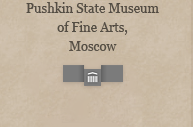PATRONS OF CONTEMPORARY ART
At the end of the 19th and beginning of the 20th century representatives of two well-known merchant families made their names as major art collectors – Sergei Shchukin and Ivan Morozov.Each of them created a large and wide-ranging gallery of contemporary art, the importance of which was far more influential than that of any ordinary private collection. The collecting activity of these patrons of the arts from Moscow was focused on the acquisition of works embodying avant-garde trends in French painting.
Russian art-lovers were able to acquaint themselves with the latest trends in European painting thanks to Sergei Shchukin (1854-1936). He came from a family of prominent entrepreneurs, who had integrated Moscow’s manufacturing industry. Sergei Shchukin had begun to collect contemporary West European painting as early as the late 1890s. When it came to the selection of paintings for his collection, Shchukin preferred to rely on his intuition. Once he had become interested in a particular artist, Sergei Shchukin would start collecting his works, which reflected how his painting evolved. Shchukin’s urge to concentrate on what was essential and most important, enabled him without fail to single out the main figures of trends in painting and so he would always find himself at the cutting edge of the avant-garde. His first serious infatuation was with Monet’s painting. That was followed by Shchukin’s enthusiasm for the work of Cézanne, van Gogh and Gauguin. This collector’s real passion, however, was for the art of Henri Matisse. Sergei Shchukin is often credited with being the first person to introduce this painter to the Russian public. In 1911, Matisse visited Russia at Shchukin’s invitation. While staying in Shchukin’s Moscow home, Matisse himself hung his canvases which were displayed there. It required great courage to buy pictures by Matisse at that time, ignoring what the public and the critics had to say.
Still greater boldness was required for a collector to dare to buy works by Pablo Picasso. Shchukin was so carried away by the work of the Paris-based Spaniard that by 1914 his collection already boasted 51 canvases by the artist. Anxious to keep pace with the rapid evolution of Picasso’s work and intuitively sensing the seeds of success in the advance of Picasso’s new painting techniques, Shchukin initially exercised restraint when buying Picasso’s paintings, but the magic of this artist had soon captivated him so strongly that, even when he did not fully understand all the changes at work in the master’s style, Shchukin used to say: “it is likely that he is right, not I”. Shchukin’s collection could with every justification be referred to as a Matisse and Picasso museum. Apart from the works of those two artists, Sergei Shchukin also succeeded in collecting some of André Derain’s finest paintings and unique canvases by Henri ‘le Douanier’ Rousseau. Sergei Shchukin’s museum was open for the public.
Ivan Morozov (1871-1921) was the second son of a powerful merchant clan owning manufactories in the city of Tver and he had become enthralled by painting as a youth, while studying at Zurich Polytechnic. In 1900 he attempted to take up painting himself, turning to Konstantin Korovin for advice. Ivan Morozov began his collection with the acquisition of works by Russian artists, but he is thought to have become carried away by contemporary art under the influence of his older brother Mikhail, who died very young. The Sisley landscape, Frost at Louveciennes, which he purchased in 1903, marked the beginning of his brilliant collection. Ivan Morozov was a painstaking, cautious man by nature and when buying pictures he would listen to the opinions of his friends – artists such as Sergei Vinogradov, Konstantin Korovin and Valentin Serov – which can be explained without doubt by his ardent desire to acquire works of exceptional quality. From 1905 onwards the artists who truly appealed to Morozov were members of the Nabis group – Pierre Bonnard, Edouard Vuillard, Maurice Denis. It was with the painters of this group that Morozov established his most lasting contacts. Denis and Bonnard created entire decorative ensembles to embellish Morozov’s Moscow home on Prechistenka Street. In 1907, Denis created his finest monumental ensemble illustrating the Story of Psyche (now in the Hermitage Museum in St. Petersburg) initially designed to decorate the concert hall in the residence of his Moscow patron. Pierre Bonnard, who had become Morozov’s favourite artist, painted a triptych entitled The Mediterranean Sea in 1910 for the staircase in that same residence and later a further two panels on the subject of the seasons. Morozov found impressive the restrained, intimate art of the Nabis group, but at the same time he was not indifferent to more avant-garde trends in 20th-century painting.
In 1907, Sergei Shchukin introduced Morozov to Henri Matisse, who subsequently painted a series of outstanding pictures commissioned by Morozov, including Moroccan Triptych. In Morozov’s collection there were only three pictures by Pablo Picasso and two of those were from his early Blue Period. Only his Portrait of A. Vollard – a work of enormous power and vitality – can be seen to embody the principles of Cubism. Morozov failed truly to appreciate that movement: he had bought the portrait only because of its striking likeness to the sitter.
Ivan Morozov’s museum was not so accessible to the public: only select connoisseurs were shown around. August 1914 put an end to Morozov’s and Shchukin’s activities as art collectors, when the First World War started. After the events of 1917 both men donated their collections to the Soviet Republic in order to protect them. Shchukin’s museum became the “First Museum of Modern Western Painting” and Morozov’s the “Second Museum of Modern Western Painting”. In the summer of 1919 Morozov succeeded in obtaining permission to go abroad for medical treatment. He travelled through Germany to Paris and on to Karlsbad, where he died soon afterwards. Shchukin settled in France, where he remained until his death in 1936.






